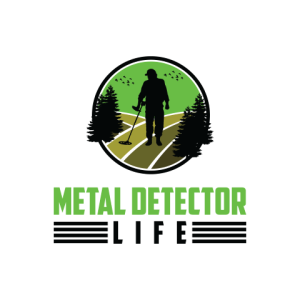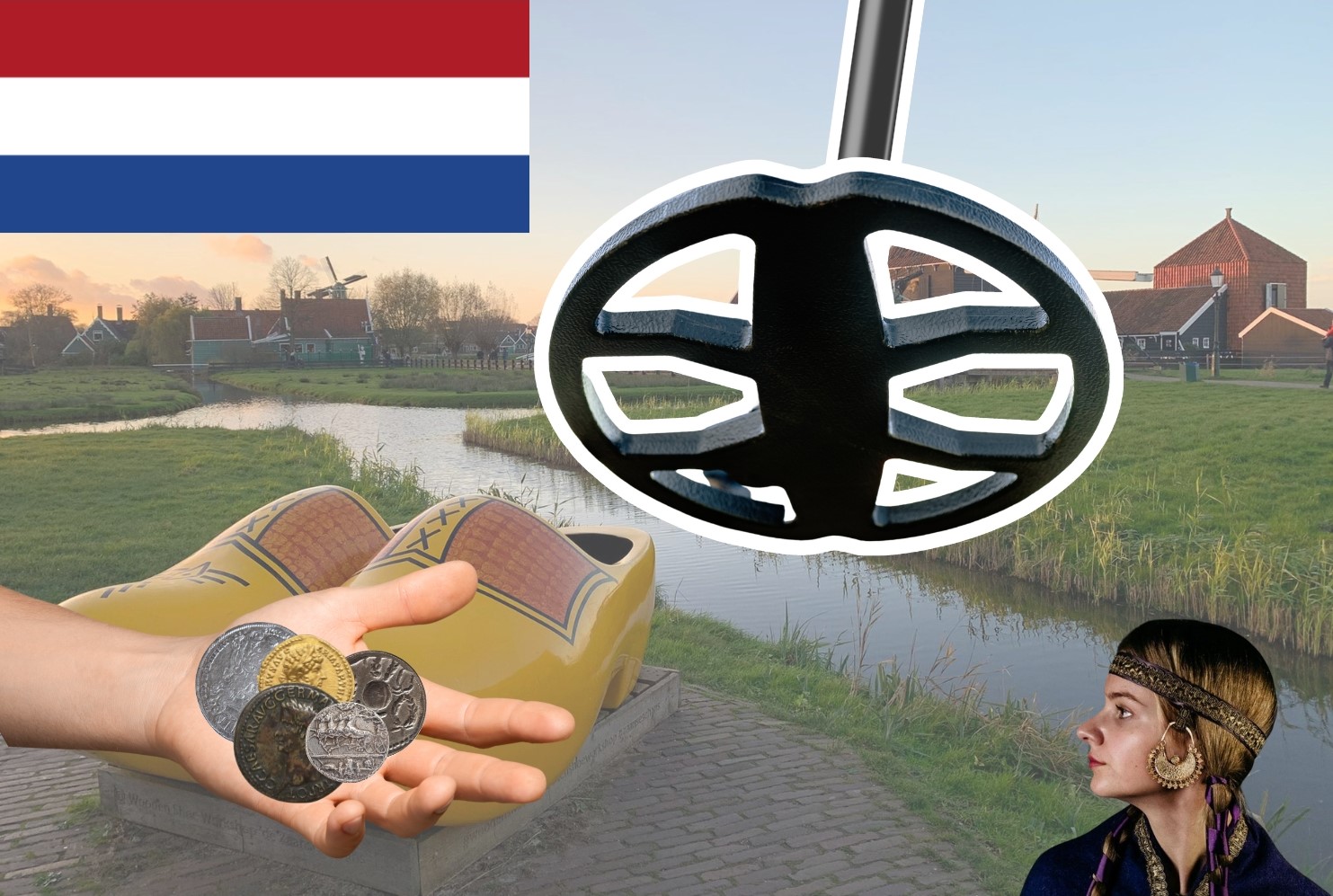Despite the relatively small size of the Netherlands, this country has an incredibly far-reaching and fascinating history. The first traces of habitation in this area date back 200,000 years ago.
Moreover, in the past century, numerous historical objects have been discovered by archaeologists as well as hobbyists like you and me!
Think about stuff like arrowheads, ancient coins, dolmens, Roman settlements, treasures, and even a massive sun calendar! It’s therefore no wonder that metal detecting is becoming increasingly popular in the Netherlands.
In this blog, I will tell you everything you need to know about metal detecting in the Netherlands. I will discuss topics such as the regulations, great locations, the history of the area, the suitable detector to use, and I will also address how to obtain permission for detecting.
Are you ready to learn all about metal detecting in the Netherlands? Enjoy reading!
The interesting history of the Netherlands

It’s incredibly interesting to understand the history of the Netherlands to know what kind of historical objects you can find while metal detecting in the country.
Prehistory
It all began in prehistoric times (until around 3000 BC). During that time, there were hunters who hunted bison, elephants, and fish. There were also farmers who made pots and other stone objects. So it’s very possible that with your metal detector, you may find things like arrowheads or other bronze or iron tools from this time.
Greeks and Romans
After prehistory came the time of the Greeks and Romans (3000 BC – 500 AD). Cities like Nijmegen, Maastricht, and Heerlen emerged (excellent metal detecting locations in the Netherlands).
In the northern part of the Netherlands, people lived on terpen and wierden. Objects you can find with your metal detector from this time are cloak pins, locks, coins (gold, silver, bronze), chains, bracelets, and weapons such as spears and swords.
The Middle Ages
After the time of the Greeks and Romans came the Middle Ages (500 – 1500). The Netherlands was ruled by kings, with Clovis as the ultimate boss.
Christianity became much more important in the Netherlands during this period, leading to the construction of many churches and other sacred buildings. Dutch cities were often plundered by Normans (also known as Vikings) during this time.
Items you can find with a metal detector from this period are medieval coins, jewelry like rings, bracelets, and amulets, weapons, religious objects like Jesus cross pendants, and household items such as cutlery, keys, tools, and locks.
The Golden Age
At the end of the Middle Ages, the king was deposed and a republic called the Dutch Republic was established. The VOC and WOC were founded, which were overseas trading companies. Ships sailed to America and Asia to trade in spices.
With the money earned from this overseas trade, the “Golden Age” emerged in the Netherlands. During this time, a lot of land was also reclaimed for livestock. Remnants you can find with your metal detector from this time are coins, buckles, buttons, locks, keys, and valuable jewelry.
Industrial Revolution and World Wars
The Golden Age came to an end when the Spanish and French attacked the Netherlands. Napoleon came to power and introduced driving on the right side and surnames. After that, the Netherlands became a kingdom.
Finally, the Industrial Revolution followed by two world wars occurred. Remnants from these times that you can find with a metal detector are bullets, weapons, buttons, and thimbles.
Metal detecting rules in the Netherlands
The Netherlands does not have overly complicated metal detecting regulations. However, it is expected that individuals strictly adhere to these rules. The following rules apply in the Netherlands:
- Always seek permission from the landowner before engaging in metal detecting on their property.
- You are only allowed to excavate finds within the top 30 centimeters (12 inches) of the ground. Objects found deeper than 30 centimeters (12 inches) should be left in the ground.
- It is prohibited to excavate anything from the submerged soil, whether using a detector or a magnet. This includes underwater areas such as rivers, lakes, and other bodies of water.
- The Netherlands has a reporting obligation to the Cultural Heritage Agency (Rijksdienst voor het Cultureel Erfgoed). This means that you are required to report any valuable finds. It is important to note the exact coordinates of your discovery when doing so. Also send an email to: pan.fgw@vu.nl
- It is prohibited to search for artifacts on archaeological monuments. The list of archaeological monument sites can be found here.
- Municipalities have the authority to impose local restrictions, such as in former war zones. The list of General Local Regulations can be found over here.
- If you find a treasure, the value of the treasure should be shared equally between you and the landowner (both 50%).
- If you discover an unexploded bomb or bullet, it is important to report it to the Explosive Ordnance Disposal Service. They are responsible for safely neutralizing and disposing of such explosives.
- Weapons or detonated ammunition dating from 1870 onwards should be left in the place where they were found. It is important not to disturb or remove these items.
- Always show respect for nature. Do not dig up or damage trees, bushes, plants, or their roots, and avoid disturbing herds in natural areas.
- If you suspect the presence of human remains, always contact the police immediately.
- Leave the area where you detect in a tidy condition. Take all of your trash with you and ensure that any holes you dig are properly filled and leveled. Keeping the environment clean and preserving the integrity of the site is important for both the landowner and future detectorists.
What is the best metal detector for the soil conditions in the Netherlands?
In the Netherlands, we often find relatively clean soils without mineralization and waste. These soils consist of sand, clay, gravel, and loam. Since detecting is only allowed in the top 30 centimeters in the Netherlands, it is wise to use a detector that can detect various objects within this uppermost 30 centimeters.
For this purpose, I recommend using a Very Low Frequency (VLF) metal detector in the Netherlands. With this detector, you will be able to detect the majority of objects, ranging from small to large and from low conductivity to high conductivity objects.
Furthermore, gold is rarely found in the Netherlands, so you don’t need a Pulse Induction (PI) metal detector. It’s best to choose a single frequency or a multi-frequency detector, both of which are suitable for metal detection in the Netherlands.
Some popular metal detectors used by metal detectorists in the Netherlands are
- The Minelab Equinox 800
- The Minelab Equinox 900
- The Nokta Makro Simplex +
- The Garrett AT Pro
- The Garrett Ace 400
Below, you can see an overview table of some suitable metal detectors that can be used in the Netherlands.










The best places to go metal detecting in the Netherlands
Due to the unique history of the Netherlands, you can also find many extremely promising locations for metal detecting here. The best places to search are old villages or cities. The oldest cities in the Netherlands are:
- Nijmegen
- Maastricht
- Utrecht
- ‘s-Hertogenbosch
- Leiden
In these areas, Roman coins, thimbles, jewelry, and other historical artifacts are often found. Therefore, it is advisable to search near one of these cities. In the picture below, you can see where these places are located in the Netherlands.
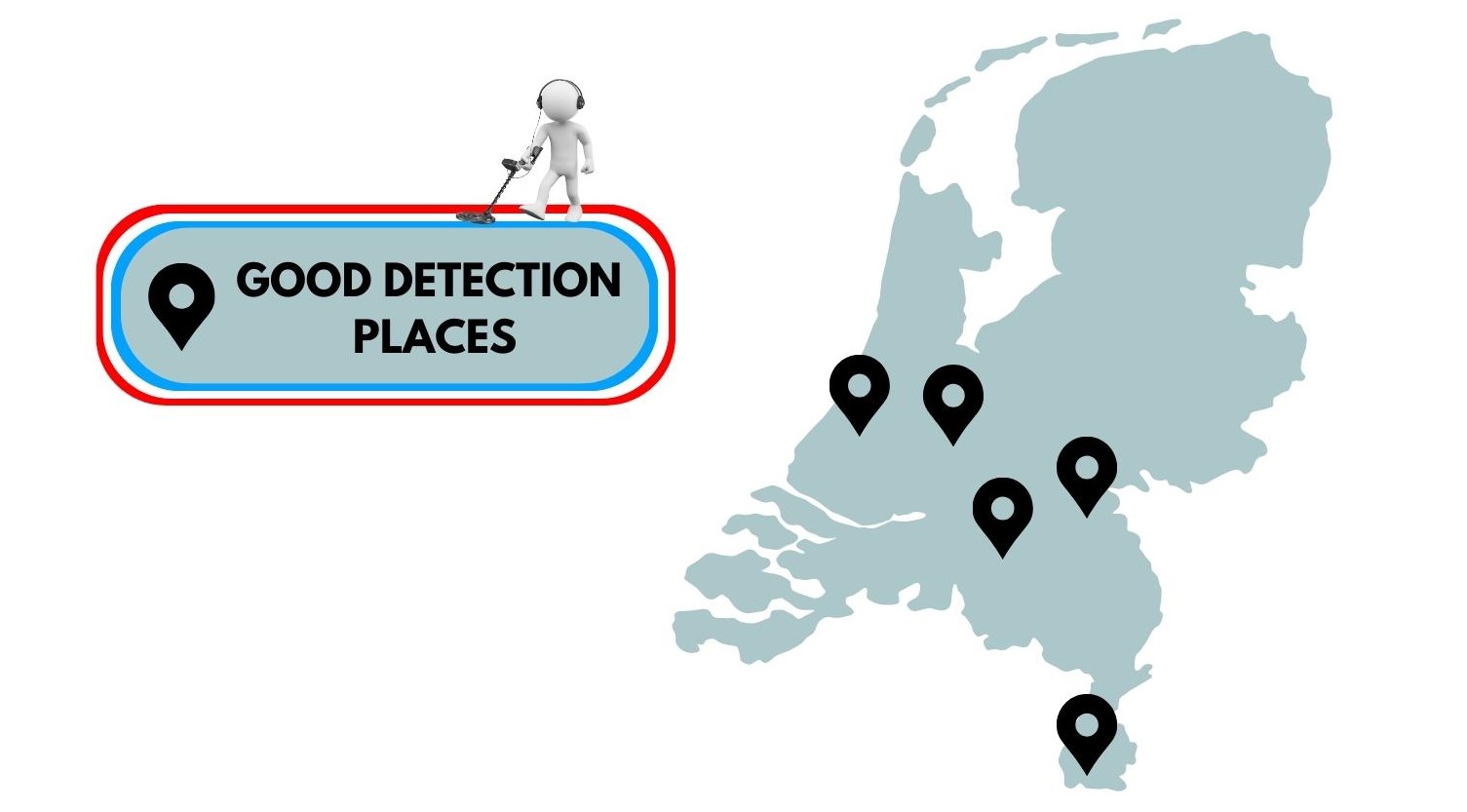
Furthermore, it is wise to search in villages with churches. The presence of churches indicates an old village center, which means that many people have lived there for a long time. The chances of finding old valuable items here are quite significant.
In addition, you will find a vast number of fields and meadows in the Netherlands. These are also excellent places for metal detecting. This is because in the past, there were often fairs, markets, and other commercial activities held in these areas. Moreover, people used to dispose of their waste (mainly old straw and hay) in these fields, where valuable items were often mixed in.
If you are more interested in finding modern valuable items such as jewelry, coins, money, or sunglasses, you can also search on the beach in the Netherlands. The entire west coast of the country is coastal area. Places like Noordwijk, Scheveningen, and Zandvoort are fantastic locations for finding modern valuable items on the beach.
The coolest things ever found with a metal detector in the Netherlands
In the Netherlands, metal detectorists of all ages have already discovered incredibly impressive historical objects.
1. Jewelry from the Middle Ages
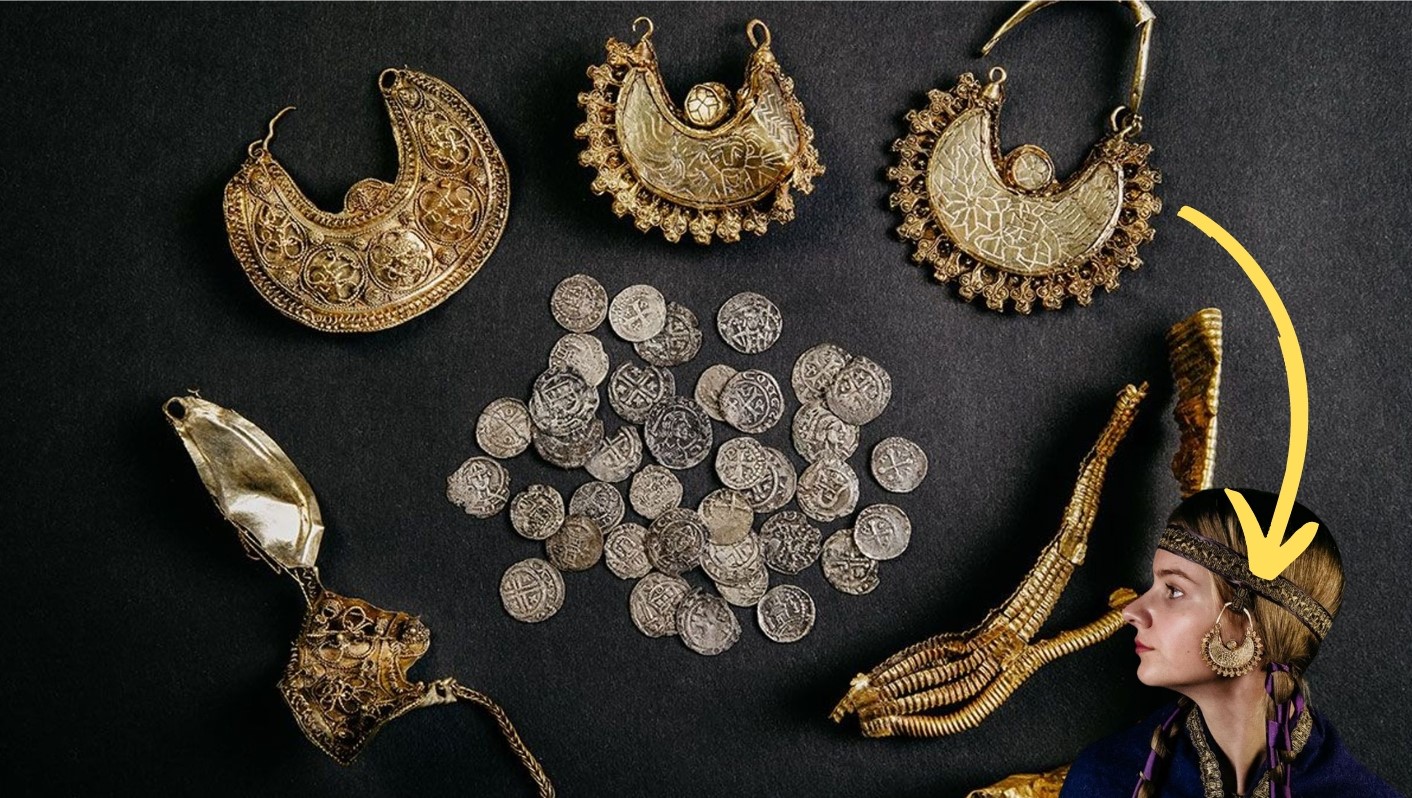
In 2021, a man from Hoogwoud discovered a fantastic medieval treasure with his metal detector in North Holland. The find consists of four gold pendants in the shape of a crescent moon, along with two matching pieces of gold leaf.
Additionally, the man found 39 silver coins. The jewelry dates back to the 11th century, making them a thousand years old. The coins, on the other hand, are from the 13th century. They were likely buried together.
2. A Nazi coin treasure
In 2020, a man from Deventer discovered a Nazi coin treasure on a field near Schalkhaar. He found over 500 German Nazi coins. Additionally, the man found German buckles, knives, buttons, and other German insignia.
Most of these items featured a swastika symbol, indicating their association with the Germans during World War II. It was an incredibly unique find!
3. Gold coins from the early Middle Ages
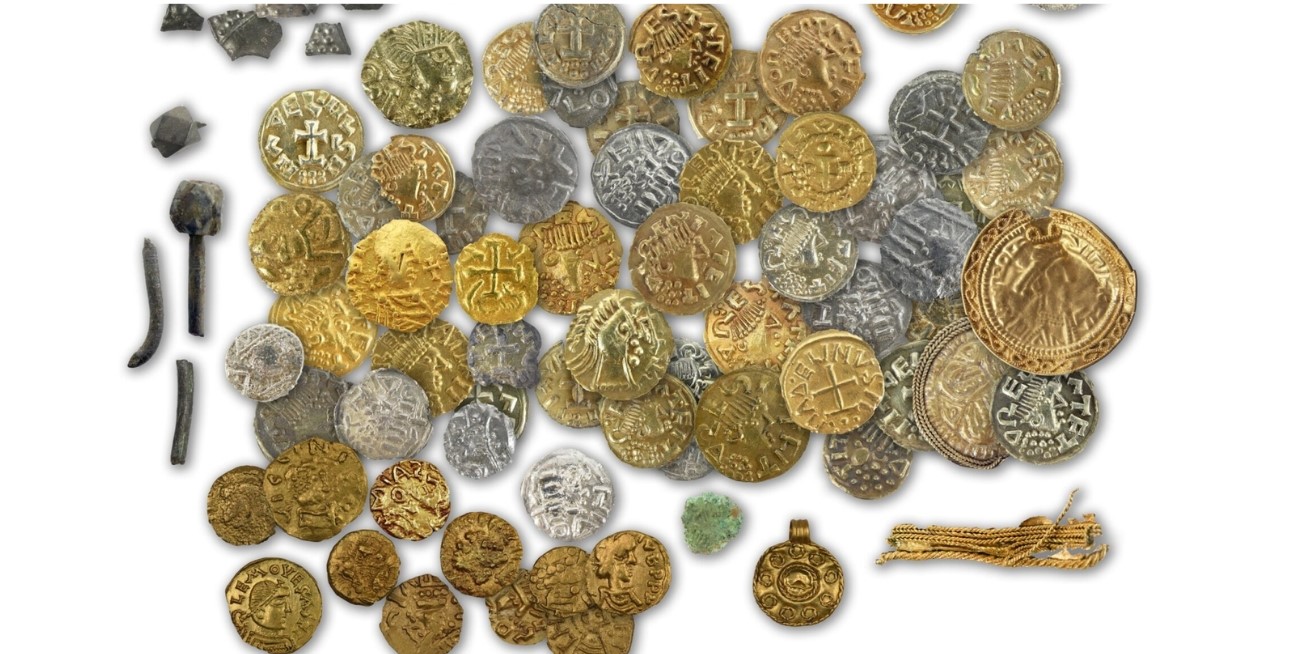
In 2022, a gold treasure from the early Middle Ages was discovered near Twente. A man found several gold coins here with his metal detector. After further investigation by archaeologists, an additional 94 coin fragments were found, including many gold and silver coins.
It is believed that these coins were buried by someone during the medieval period. Once again, it is an extremely unique find!
4. Other cool treasures
Of course, many more cool things have been discovered in the Netherlands with metal detectors that have not been reported to local authorities. In the country, various items like military helmets, military buttons, arrowheads, a golden crown, gold rings, ancient coins, and thimbles have also been found.
How to get permission to go metal detecting in the Netherlands?
It is relatively simple to request permission for metal detecting in the Netherlands. You need to contact the owner of the land where you want to detect.
Often, the owner is an individual. The only drawback is that you may not always know who owns a piece of land. Fortunately, there are several things you can do to find a landowner in the Netherlands.
The easiest way is to knock on the doors of people living near the land in question. They often know who owns the land. If that doesn’t work, you can use another method, which is accessing the official cadastre data. Usually, you only need to pay a one-time fee of €15/$15 to find the owner.
In the Netherlands, there are three suitable websites where you can access the cadastre data:
You will probably see something like this:
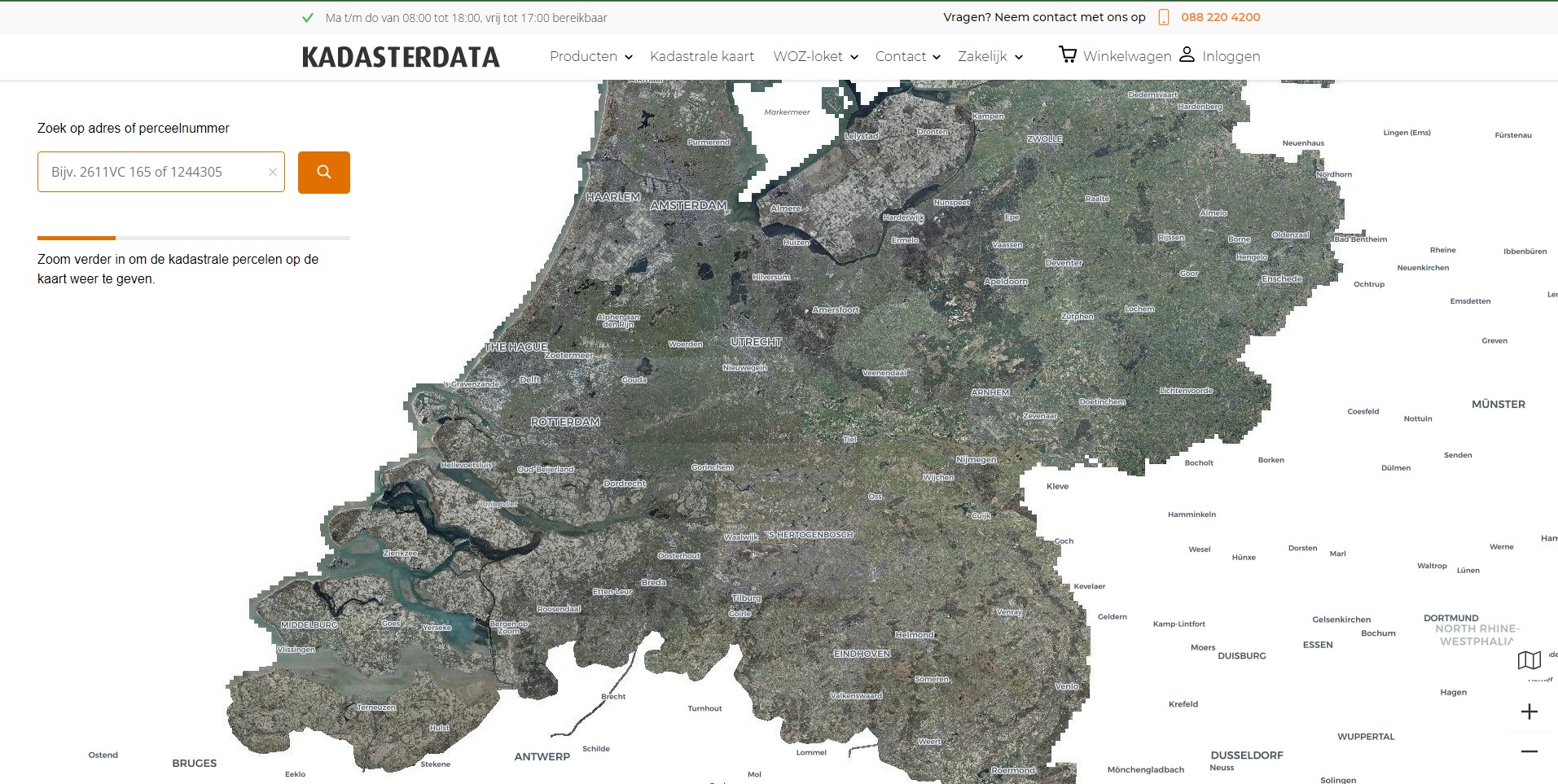
Am I allowed to metal detect on the beach in the Netherlands?
Whether or not you are allowed to metal detect on the beach depends on the specific municipality. It is governed by the Algemene Plaatselijke Verordening (APV), which can be found online. Therefore, it is advisable to contact the relevant municipality to inquire about permission to metal detect on the beach
Are there metal detecting clubs in the Netherlands that can be joined?

Yes! In the Netherlands, there are primarily two major metal detector clubs that you can join if you’re interested. These metal detector clubs are:
- The Coinhunters Company
- DDA Nederlandse vereniging voor metaaldetectie (Dutch Association for Metal Detection)
Both clubs periodically release magazines for their members and organize search days and other events. It’s a great opportunity to meet new people who share the same passion!
Below, you can find the contact information for both metal detector clubs, in case you’re interested. Feel free to reach out to them if you’re interested!
| Metal Detecting Club Name | Contact Information |
|---|---|
| The Coinhunters Company | Website: www.thecoinhunter.com |
| Email: coinhuntermagazine@hotmail.com | |
| DDA Nederlandse vereniging voor metaaldetectie | Website: www.detectoramateur.nl |
| Email: secretariaat@detectoramateur.nl |
Furthermore, the Netherlands has several enjoyable forums where metal detectorists help each other identify their finds. They also share inspiring stories and provide tips to one another. The four largest forums in the Netherlands are:
These forums offer a great platform for connecting with fellow enthusiasts and expanding your knowledge in the metal detecting community.
My personal best finds in the Netherlands
I have also frequently metal detected in the Netherlands myself. During my searches with my Garret Ace 400 detector, I have managed to find several incredibly unique, valuable, and ancient objects. Therefore, I briefly mentioned some of the most remarkable items I have discovered in the country below.
1. Menno van Coehoorn military beret

In the Netherlands, I found this fantastic beret. It has “Menno van Coehoorn” written on it. He is one of the most versatile military figures in Dutch history. He served as a troop commander and developed multiple innovative weapons for use in war.
This beret most likely dates back to the period between 1641 and 1704! Therefore, it’s truly a one-of-a-kind discovery!
2. Military Button from the world war II

Another fantastic find I made with my metal detector in Holland is this military button from a Dutch soldier. It features two lions, which is highly characteristic of the Netherlands.
The button dates back to the Second World War when the Netherlands was in conflict with Germany. I found this button in Limburg, near the border with Germany. It is highly likely that a soldier lost it during a battle.
3. Various coins

Lastly, I have found several unique coins in the Netherlands with my detector, dating from different time periods. I have discovered coins from the 1700s, 1800s, and 1900s. In the photo above, you can see a coin from 1755 and two coins from 1835!
Frequently Asked Questions
In the Netherlands, you can discover various valuable ancient objects. Think of findings such as coins, thimbles, bullets, jewelry, relics, cutlery, and other valuable items.
Yes, in most cases, you are allowed to keep your findings. This is especially true when you find an object on private property within the top 30 centimeters (12 inches) of the soil. However, if you come across an object of historical value, you are required to report it to the Cultural Heritage Agency of the Netherlands (Rijksdienst voor het Cultureel Erfgoed). They will want to examine and potentially acquire the object for further study.
Yes, you are allowed to use metal detectors on private properties and farmland when you have permission from the owner of the land. Therefore, always seek permission before you go metal detecting!
